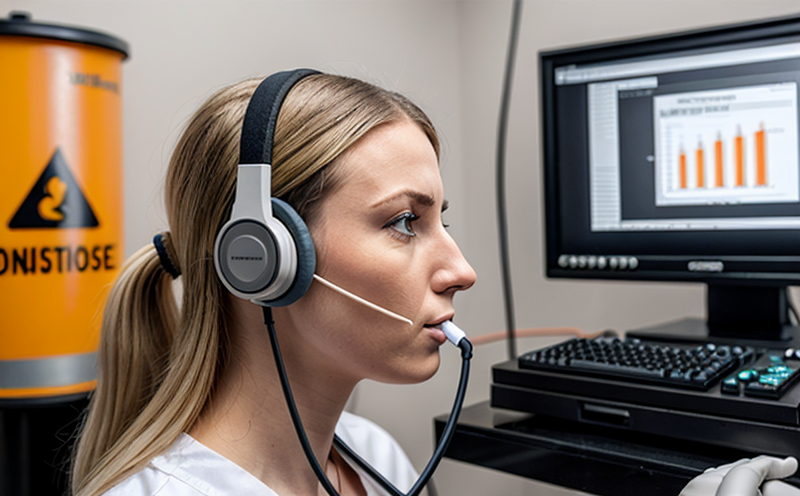ISO 4869-1 Hearing Protector Attenuation Measurement (REAT)
The ISO 4869-1 standard specifies a procedure for measuring the attenuation of hearing protectors using Real Ear Attentuation at Threshold (REAT). This method is crucial in ensuring that hearing protection devices effectively reduce noise exposure, thereby protecting workers from occupational hearing loss. Occupational noise exposure testing is essential in industries such as manufacturing, construction, and mining, where high levels of noise can be harmful to employees.
REAT measures the attenuation of a hearing protector by directly measuring sound pressure at the eardrum using a probe microphone placed in the ear canal. This approach provides accurate data on how much protection is being delivered by the hearing protector as it would be worn by the worker. It is particularly useful for noise reduction rating (NRR) calculations, which are used to inform workers and employers about the expected effectiveness of the hearing protectors.
The testing process involves several steps: first, the probe microphone is inserted into the ear canal, followed by placing a sound source in front of the subject. The sound pressure level (SPL) at the eardrum is then measured both with and without the hearing protector in place. The difference between these two measurements gives the attenuation value for that specific hearing protector.
The accuracy of REAT testing is influenced by various factors, including probe microphone calibration, proper fitment of the hearing protector, and environmental conditions such as room temperature and humidity. Proper specimen preparation, which includes cleaning the ear canal and ensuring the probe fits snugly in the ear canal, is also critical for obtaining reliable results.
The data obtained from REAT testing can be used to assess the adequacy of a worker's hearing protection and to determine whether additional measures are needed to reduce noise exposure. This information is essential for maintaining compliance with occupational safety regulations such as OSHA 29 CFR 1910.95, which mandates the use of engineering controls and administrative controls when noise levels exceed specified limits.
Employers must ensure that workers receive training on the proper use and fitment of hearing protectors to maximize their effectiveness. This includes understanding the limitations of REAT testing, such as the variability in results due to different ear canal shapes and sizes. By adhering to ISO 4869-1 standards, laboratories can provide accurate and reliable data that contribute to worker safety and compliance with international regulations.
Applied Standards
| Standard | Description |
|---|---|
| ISO 4869-1 | Procedure for measuring the attenuation of hearing protectors using Real Ear Attentuation at Threshold (REAT). |
| ANSI S3.22 | American National Standard Method for Measurement of Hearing Protectors by Real-Ear Attenuation at Threshold (REAT) Technique. |
| BS EN ISO 4869-1 | European standard equivalent to ISO 4869-1, providing the same procedure and requirements. |
| IEC TS 62731:2021 | International Electrotechnical Commission Technical Specification for measurement of hearing protector attenuation using REAT technique. |
EuroLab offers comprehensive and accurate ISO 4869-1 testing services, ensuring that employers meet their legal obligations under occupational safety regulations. Our team of experts ensures that the testing environment is controlled and standardized to minimize variability in results. We use state-of-the-art equipment, including precision sound source systems and high-quality probe microphones, to provide reliable data.
Our laboratories are equipped with the latest technology to perform REAT tests efficiently and accurately. Our experienced technicians have extensive knowledge of ISO 4869-1 standards and can guide you through the entire testing process, from specimen preparation to final analysis. We offer fast turnaround times for test results, ensuring that you receive timely data to inform your decision-making processes.
At EuroLab, we understand the importance of accuracy in REAT testing. Our laboratories are accredited by leading accreditation bodies, such as ISO/IEC 17025, ensuring that our testing methods meet international standards for precision and reliability. We provide detailed reports with all relevant data, including attenuation values, probe microphone calibration certificates, and environmental conditions during the test.
Our commitment to quality and accuracy is reflected in the consistent results we deliver across multiple tests. We have a proven track record of providing reliable data that can be used to inform decisions on worker safety and compliance with regulations. By choosing EuroLab for your ISO 4869-1 testing needs, you ensure that your testing process meets international standards and provides accurate insights into the effectiveness of hearing protectors.
International Acceptance and Recognition
The ISO 4869-1 standard is widely recognized and accepted across many countries. It has been adopted by numerous national standards bodies, including ANSI in the United States, BSI in the UK, and DIN in Germany. This widespread adoption ensures that test results obtained using this method are universally comparable.
Employers who comply with ISO 4869-1 can be assured that their compliance efforts will be recognized internationally. Many countries have incorporated the requirements of this standard into their occupational safety laws and regulations, making it a key component in ensuring worker protection against noise-induced hearing loss.
The international acceptance of ISO 4869-1 has led to its use in various industries where noise exposure is significant. By adhering to this standard, employers can demonstrate their commitment to worker safety and compliance with global best practices. This is particularly important for companies operating internationally, as it ensures consistency across different regions.
The widespread recognition of ISO 4869-1 also facilitates data sharing between laboratories in different countries. This interoperability allows for more robust research and development efforts in the field of hearing protector attenuation measurement, leading to continuous improvement in safety standards.





